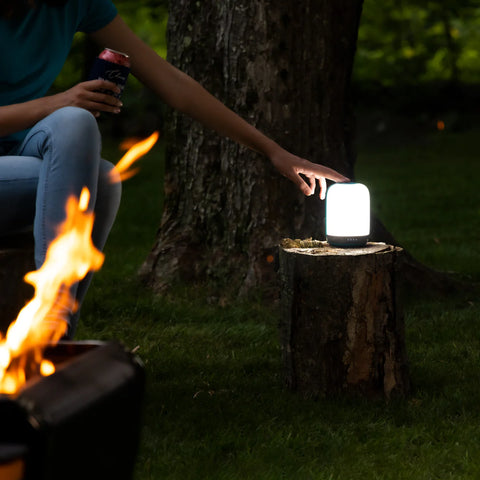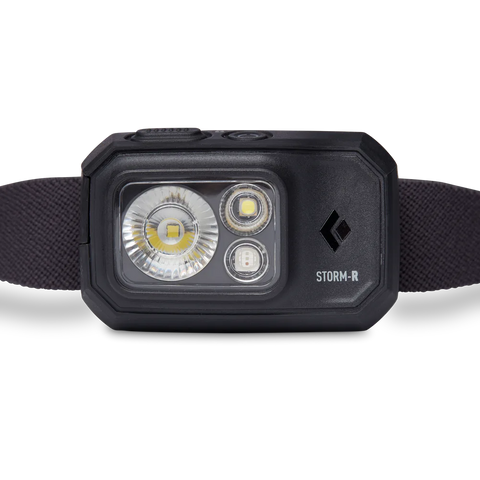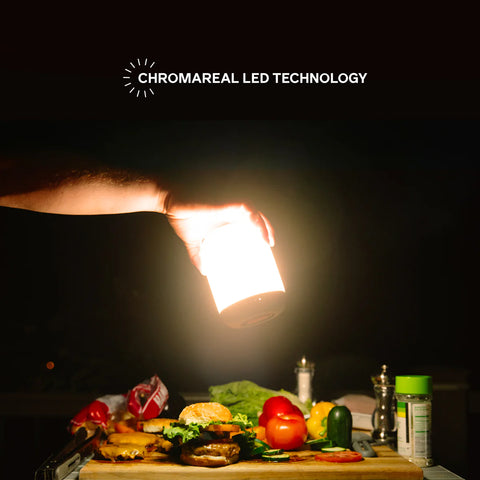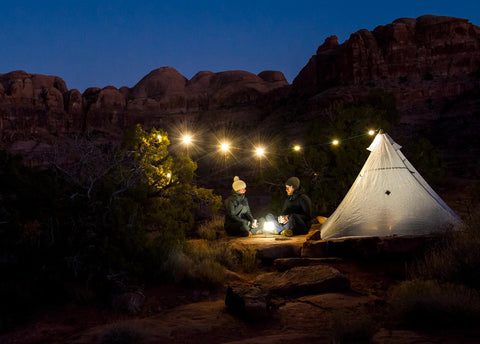If you're looking for portable lights for your outdoor activities, you've come to the right place. We have a wide selection of portable LED lights that are ideal for camping, hiking, or any other outdoor use. Whether you need a handheld LED light, a headlamp, a hanging light, or any other type of portable lighting, we have it all.
We only stock portable lights that are made with high-quality materials and advanced technology to ensure long-lasting performance and durability. At the same time, they are easy to operate and customize to your liking. Most portable lights available at Biome allow you to choose from different modes, colors, and brightness levels to create the perfect ambiance for your surroundings. Plus, they're all rechargeable and eco-friendly, so you don't have to worry about batteries or waste. Include a Biolite solar panel in your setup for unlimited power from the sun!
What is the best camp light?
This is a subjective question, as different campers have different preferences and needs. However, some of the features that make a good camp light are:
- High lumen output: Lumens measure how much light a source emits. Generally, the higher the lumens, the brighter the light. However, brightness also depends on other factors such as beam angle and distance. For camping, you may want a light that can produce at least 100 to 200 lumens per lantern, or more if you have a large group or area to cover.
- Long battery life: You don't want your light to run out of juice in the middle of the night, so look for a light that can last for several hours on a single charge or set of batteries. Some lights also have a power bank function that allows you to charge your mobile devices from them.
- Durable and water-resistant: Camping can expose your light to harsh weather and rough handling, so look for a light that can withstand drops, bumps, and splashes. Some lights are rated by IPX codes that indicate their level of water resistance. For example, IPX4 means the light can resist splashing water from any direction, while IPX7 means it can be submerged in water up to one metre deep for 30 minutes.
- Weight: This is particularly important if you are hiking. Whether you want a backup headlamp for your pack or are planning a multi-day hiking trip, you need weight to be kept to a minimum to reduce fatigue. Headlamps are a great option for hikers, as they allow hands-free lighting in a compact, lightweight package.
- Colour options: Some lights offer different colour modes that can create different moods and effects. For example, warm white light can create a cozy and relaxing atmosphere, while red light can preserve your night vision and deter insects. Some lights also have colour-changing or flashing modes that can add some fun and flair to your campsite.
- Power type: There are many different options for how your light is powered. Traditionally, portable lights and camping lights have been powered by batteries. However, as lithium battery technology gets better, rechargeable lights are starting to take over the market. Paired with a portable solar panel, a rechargeable light will have battery indefinitely, providing light when you need it most.
Based on these criteria, some of the best camp lights on the market are:

- BioLite AlpenGlow 500 Lantern: This lantern has a 6400 mAh rechargeable battery that can also charge your devices via USB. The AlpenGlow series features two main light modes: white and colour. The white mode offers 500 lumens of bright and natural light, while the colour mode uses ChromaReal LED technology to produce full-spectrum colours that can change or fade according to your preference. The lantern also has a shake-to-change function that lets you switch modes by shaking it gently, as well as strobe party modes for when the campsite inevitably turns into a dancefloor. The AlpenGlow 500 has a little brother, the AlpenGlow 250. The AlpenGlow 250 has a maximum output of 250 Lumens and is perfect for the weight or cost conscious camper.

- Black Diamond Storm 500-R Headlamp: This headlamp from Black Diamond is a high output (500 lumen), rechargeable, weather-proof headlamp, perfect for serious campers and hikers. It features an ultra-comfortable Repreve fiber strap made from recycled elastic, a 2400mAh battery and IP67 waterproofing, meaning it has been tested to work at 1m underwater for 30 minutes. With a bunch of other smart features to help you save power and preserve night-vision, the Storm 500-R is a premium headlamp.
What is the best colour light for camping?
The best colour light for camping depends on your purpose and preference. Generally speaking, warm white light is more comfortable and relaxing for the eyes than cool white light, which can be harsh and glaring. Warm white light also mimics natural sunlight better than cool white light, which can help regulate your circadian rhythm and sleep quality.
However, some campers may prefer other colours for specific reasons. For example:
- Red light: Red light has the longest wavelength and the least impact on your night vision. This means it won't interfere with your ability to see in the dark or disturb other campers who are sleeping nearby. Red light also tends to attract fewer insects than white light, which can be helpful if you want to avoid getting bitten or annoyed by bugs. We stock a variety of headlamps with red light settings.
- Green light: Green light has a shorter wavelength than red light but still preserves your night vision well. Green light also has a calming effect on the mind and body, which can help you relax and sleep better. Green light is also easier to see from a distance than red light, which can be useful if you want to signal or locate someone in the dark.
- Blue light: Blue light has the shortest wavelength and the most impact on your night vision. This means it will make everything look brighter and clearer, but also make it harder to adjust to the dark afterwards. Blue light also has a stimulating effect on the brain, which can keep you alert and awake. Blue light is also the most visible colour in the dark, which can be helpful if you want to draw attention or warn someone of danger.
- White light: True white light is a combination of all wavelengths of light. For this reason, white light is excellent around a campsite when you are trying to cook something, draw, write or read, or any other time you are not trying to preserve your night vision. Biolite's ChromaReal technology is a fantastic feature that helps colours appear as they do in sunlight. See the image below for an example.

How many lumens do I need for a tent light?
There is a formula you can use to estimate the number of lumens you will need to light an area. It is just a rough guide, so it is important to remember that depending on your setup, individual needs or preferences, a different amount of light may be appropriate. It is also important to consider that our eyes can adjust to much lower levels of light than we are usually exposed to on a day to day basis. Now, follow closely, because there's about to be some technical terms thrown around.
The first information you need to know are the usual light levels we are exposed to on a day to day basis. These will be a helpful reference point for later in the process. The amount of light falling on a surface (illuminance) is measured in Lux. Here are some illuminance values that should help you establish a frame of reference.
- Full daylight: 10 000 lux.
- Overcast day: 1000 lux.
- Office lighting: 500 lux.
- Living room lighting: 300 lux.
- Bedroom lighting: 100 lux.
- Moonlight: 1 lux.
Remember, while it might seem tempting to aim for office lighting in an outdoor space, office lighting is usually generated by multiple huge fluorescent tubes. Reaching the same level of illumination with some battery powered portable lights is unrealistic. In fact, you will likely find that your eyes can comfortably adjust to much lower levels of illumination than you expect, even below 100 lux!
Now, the number of lumens you need for a camping light depends on area you are trying to illuminate and the level of illumination you are after. Generally, you can use this formula to estimate how many lumens you need:
Lumens = Illumination area (in square metres) x Desired brightness (in lux)
For example, if you have a 2-person tent that measures 2 x 2 metres, and you want a brightness level of 100 lux, you can calculate the lumens as follows:
Lumens = 2 x 2 x 100
Lumens = 400
This means you need a tent light that can produce at least 400 lumens of light. However, this is only an approximation and may vary depending on other factors such as the shape and colour of your tent, the distance and angle of your light source, and the presence of other light sources nearby. In reality, if you give your eyes enough time to adjust, 250 or even 100 lumens can be enough to light the inside of your tent.

Additionally, while lights such as the Black Diamond Storm 500-R can emit 500 lumens, the beam is quite narrow. This essentially restricts the area being illuminated, unless you were to position the headlamp up high where the beam has enough time to disperse before reaching the surface. For headlamps, this isn't much of an issue, because the light will be shining wherever you are looking. Lanterns such as the Black Diamond Moji range or BioLite AlpenGlow emit their light in essentially all directions.
How many lumens do you need to light a campsite?
Lighting a whole campsite can be tricky and is why campers often resort to individual headlamps. However, it can be done. Read on for more info.
Say your campsite was a 10m x 10m space. Using the same formula as before, if you wanted living room levels of brightness across your whole campsite, you would need an output of 30 000 lumens. So, does this mean you should go and buy 60 AlpenGlows? The short answer is no... while we would appreciate the business, there are other workarounds.
As mentioned earlier, headlamps are a great option for campers and hikers. They allow hands-free lighting in the exact place you are looking, meaning you aren't wasting lumens illuminating a random corner of your site that has nothing on it.
Alternatively, if you do want to light practically all areas of your site, we would recommend going with a few smaller lights strategically positioned. Biolite's Sitelight series features a range of daisy-chainable LED lights that can be powered by a single USB port. They are great for lighting large areas, especially when you remember that it's okay to let you eyes adjust to lower levels of light than you are used to at home. They can be powered by any of the basecamp-charging-station style lanterns available from Biome.

How do you light a tent at night?
There are many ways to light a tent at night, depending on what kind of light source you have and where you want to place it. Here are some common methods:
- Hang a lantern from the ceiling or a hook inside your tent. This will provide even and bright illumination for your entire tent. However, it may also create glare or shadows depending on the angle and position of the lantern. See the image below for an example of the Biolite Sunlight 100 being used as a tent light.

- Place a lantern or flashlight on the floor or a table inside your tent. This will provide focused and directional illumination for a specific area or task in your tent. However, it may also create dark spots or blind spots depending on the angle and position of the lantern or flashlight.
- Attach a string light or fairy light around the perimeter or across the ceiling of your tent. This will provide soft and ambient illumination for your entire tent. However, it may also create less visibility or contrast depending on the colour and brightness of the string light or fairy light.
- Use a headlamp or flashlight to wear on your head or hold in your hand. This will provide personal and portable illumination for wherever you look or go in your tent. However, it may also create annoyance or disturbance for other people in your tent depending on the direction and intensity of the headlamp or flashlight.
But What About Power?
We are proud to only stock lights if they are somewhat rechargeable, whether that is through an integrated solar panel (such as the Biolite Sunlight 100) or through a micro-USB port. However, what happens when they go flat half way through your camping trip in the middle of nowhere?
Luckily for you, we have another solution. Introducing the Biolite 5+ and 10+ Solar Panels.
These clever contraptions feature an integrated battery that can store power even when the sun is no longer shining. This makes them an absolute essential on any camping trip that lasts more than a couple days. Use a panel to charge up your basecamp charging lantern at the same time as the panel charges it's internal batteries. Come nightfall, you will have two full portable chargers ready to power your other lights, charge your devices or simply wait as a backup in case of emergency. Simple as that.

 SaleRegular price $133.84Regular priceUnit price per
SaleRegular price $133.84Regular priceUnit price per
 SaleRegular price $71.38Regular priceUnit price per
SaleRegular price $71.38Regular priceUnit price per

























































